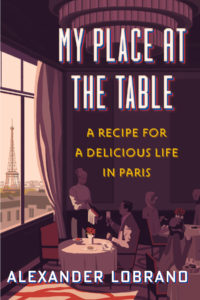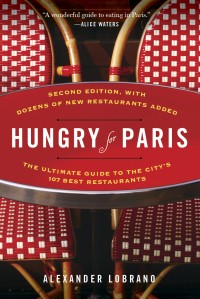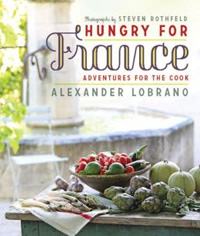Les Paillotes at Les Etangs de Corot: A- ; Laperouse, Paris: C; And Shame on Lactalis!
Lunch with my friend Alain on Wednesday, and what a pleasure it was to hop in his car and head for the country just long enough for some bird song and fresh air to unknot a morning’s tensions. Our destination was Les Paillotes, the summer restaurant at Les Etangs de Corot, a charming country hotel that’s recently been renovated by the family who own and run the Caudalie line of spas and skin products, and they’ve done a beautiful job of creating a bower of bliss on the door steps of Paris. Once a getaway for the painter Corot, who loved the bucolic atmosphere of what was then a country village outside of Paris, Ville d’Avray today is one of the rare Parisian suburbs to have retained a palpable sense of its original rural identity, much of which comes from the etangs, or ponds, Corot once made a subject.
What makes this place especially pleasant during the summer is that they have a raised, thatched roof terrace–Les Paillotes–overlooking the pond behind the hotel where they serve during the summer. Having been to the hotel to sample the cooking of their talented chef Benoit Bordier during the winter, I was curious to see how he’d settled in. Though I enjoyed my last meal, I found the service over-groomed and Bordier’s cooking much too cerebral and self-regarding for this new setting.
I’ve been following Bordier ever since I first discovered him at Chez Jean, just down the street from me in the 9th arrondissement, some ten years ago. In particular, Bordier is one of the most gifted fish cooks working in France today and also has a wonderful modern way of cooking vegetables and including seasonal fruit in his recipes. Anyway, suffice it to say, that I retrieved the Bordier whose cooking I’ve always so deeply appreciated during the course of a superb and refreshingly simple lunch. I started with a wonderful chunky raw green-pea soup poured over an oval of ham-flavored carrot puree, and it was a truly brilliant summer appetizer. Next, a slice of pork belly that had been slow cooked for hours to be spoon tender, then grilled, and finally served with a garnish of chopped black cherries and a wonderfully astringent sauce of lovage and juiced apricots. Again, an outstanding dish, at once humble and deeply considered. Dessert was excellent, too–what could have been better than poached white nectarines with freshly made pistachio ice cream and buckwheat honey financiers.
I’d be planning to eat at Les Paillotes often during the month of August if they hadn’t rather eccentrically decided to close from July 26th through August 18th. So go this weekend, or catch up with the same excellent summer menu when they reopen.
——-
Before dinner the other night, I hadn’t been to Laperouse, that old war horse of a restaurant on the Quai des Grand Augustins in the 6th arrondissement for over ten years. The last time I was there turned out to be one of the most memorable meals of my life, too, since I happened to catch chef Pascal Barbot and maitre d’hotel Christophe Rohat, ex-Arpege, during the cameo appearance that they made here before going on to open their brilliant restaurant L’Astrance, one of my very favorite tables in Paris.
My English friend Madge was chomping at the bit to give this place another go, though–they’ve just hired a new chef–so off we went on a stiffling summer night with high hopes. Arriving, the restaurant made the same impression as an older, over-dressed woman who’d dozed off in her box at the races. To say there was no social or gastronomic tension on the premises would be to put things mildly indeed. But I love me Madge, and so was bright eyed and busy tailed for this meal. Unfortunately, things got off to a decidedly wrong-footed start when the waiter told us that he was glad we were there so that he could practice his English. I know he meant well, but he wasn’t shrewd enough to realize that the none too subtle message he’d just delivered was that he had taken us for tourists, a social gaffe indeed when we hadn’t exchanged more than five words. This same high-handed, back-up service irritated me all through the meal–it was as though the crew here insisted that we be subjugated to their preconception that we were tourists for no other reason than the fact that we were speaking English.
Oh, and the food. Lots of giggles, since there were dots of sauce and tiny pansies scattered over almost everything. If you happened to have missed la nouvelle cuisine the first time it went round, this is the place to come for a right-out-of-the-original-anthology of same. Though Madge’s terrine of heirloom tomatoes was very pretty to look at and made her happy, my “green gaspacho” was a drab business, the worst bit being the garnish of way over-the-hill langoustines wrapped in phyllo pastry and deep-friend. Next, my sea bass filet was nicely cooked, but the garnish of red endive and fig sauce acidulated with Banyuls vinegar completely overwhelmed it.
Stuffy, expensive and out-of-date, Laperouse offers a veritable catalogue of the most extreme flaws of French cooking at its most hidebound in 2009.
—————–
The red-and-gold label of the round wooden LE PETIT camembert box has been one of the most reliable emblems of pleasure in my life for many years. Even when I didn’t have the time to seek out a really good fromagerie, I could pick up a raw-milk LE PETIT camembert in any Parisian grocery store, which is exactly what I did the other day when I was more or less on the mend from a serious case of Eastern European food poisoning. Monsieur Le Docteur had told me to avoid dairy like the plague for at least five days, but after three days of Japanese rice and bouillon, I jumped the rails while buying paper towels and dish soap at my local worst-case (i.e., don’t have time to walk any further) supermarket. On my way to the cash register, the red and gold label flashed, and I thought, oh, blink it, I haven’t eaten a good camembert in way too long, lifted the lid on one, found it perfect to thumb pressure, and dashed home to smear it all over some toasted pain Poilane.
Unwrapping the waxed paper that contained the cheese, I was literally chomping at the bit, and when the toast jumped in the toaster, I brushed it with good olive oil and gave it a sprinkle sea salt and piment d’Esplette and sat down at the kitchen table for my treat with a glass of Morgon. Engrossed in the latest issue of The Economist, I was perhaps less attentive to my cheese than I might have been, but after less than a minute I knew that something had gone wrong.
Yes, the cheese was as runny as one could hope, but it lacked the mellow, earthy, mushroom-y goodness that has always made me love camembert. On a hunch, I dashed to the fridge and yanked the box out. No where did I see those most important words for any camembert lover: LAIT CRU (raw milk). The creeps had gone through with what they’d been threatening, which was to start making one of France’s most emblematic cheeses with pasteurized milk.
So Lactalis, this God-damned industrial dairy thought they could sneak under the radar after all. Last year they admitted they weren’t going to be making much raw-milk camembert anymore, but then sort of backed down following an outcry. What followed was that camembert seemed to disappear–only the nastiest brand of all, Le President, was still regularly available at my local market, which is why the reappearance of LE PETIT made me so happy.
Bait and switch is what they’ve done, however. And I’ll not only never buy a LE PETIT camembert again, but went on to the Lactalis website to see what else they make so that I can very purposefully boycott it. I suggest you do the same–if France stops making raw-milk cheeses, the world will be an infinitely poorer and sadder place.
——-
Les Etangs de Corot, 55 rue de Versailles, Ville d’Avray, Tel. 01-41-15-37-00. Average 40 Euros.




